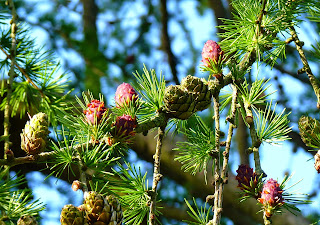I've been a little bit preoccupied with watching the woodpeckers visiting that nest in the ash tree when going on my walks in the hills. The other morning I stood away from where the nest is and watched the adults go to the surrounding trees to forage for the grubs to be fed into those waiting hungry mouths. In that area there are a number of larch trees and one or two of them appear to be dead being leafless and riddled with holes. The woodpeckers often went to these for food but I couldn't photograph them as they moved energetically around the trunk appearing and disappearing from view.
Then I remembered that I'd meant to take some pictures of the larch trees so I abandoned woodpecker watch to see if I'd left it too late to see the bright red female cones. Well, there were some and I was pleased not to have missed them completely this year.
There are quite a few larch around the Welcombe Hills. In winter they drop their needles and look lifeless. But in the spring the soft green needles appear followed by the bright red cones that will hold the seeds. The emptied cones from the previous year remain on the tree throughout the winter and the following year.
Turning to walk back home down from the reservoir area towards the Welcombe Hotel I passed a tree that was definitely dead - a Horse-chesnut that has been standing for a number of years in an undignified state of decay. Attempts by youngsters to set it alight have failed but left it charred and quite spooky. Over the years I've seen a number of mature trees die and eventually fall. More often than not the culprit is honey fungus which, once it appears signals the end for the tree.
It often called the bootlace fungus and in that name is the clue to it's destructiveness. The evidence that his horse-chestnut tree was killed by the honey fungus or one of the other destructive fungi can be found beneath the bark. Remove some and the web of black rhizomorphs can be seen - hence the name bootlace fungus.



No comments:
Post a Comment